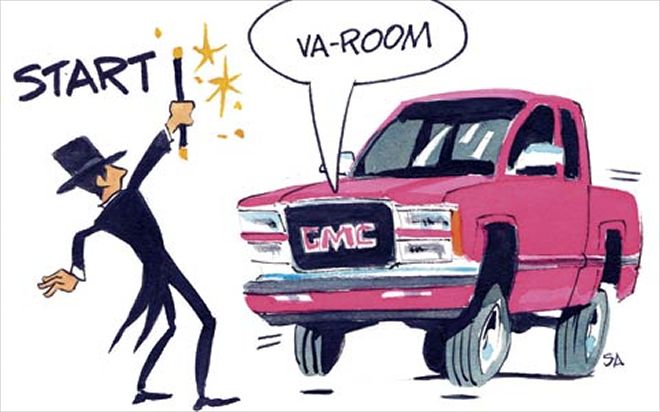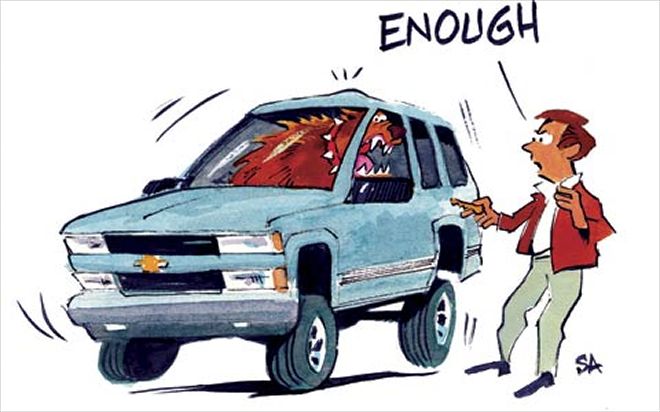
| 163 0504 Ttg01 Z
To Cruise or Not To CruiseQ:I recently purchased a 2004 Jeep Wrangler (with an automatic and A/C) to drive, since I'm getting too old to play with an antique, which was my first choice. The Wrangler doesn't have cruise control. That's no big deal in itself, but initially the salesman led me to believe I could install it myself. He later reneged and said it was quite hard to do. Can I install the cruise control or not?
A:It can be a complicated installation, one you may not want to do yourself. Mopar sells an original-equipment speed-control system for the 2004 Jeep Wrangler (part 82208190 for the 4.0-liter, 82208195 for the 2.4-liter engine) for about $235. The estimated professional labor time to install the system is 1.2 hours. The toughest part is installing the cruise switch, which requires removal of the steering wheel and partial disassembly of the steering column. This involves the use of special tools and working with potentially hazardous airbag components. In addition, you should research your particular Wrangler's date of assembly. Mopar notes that vehicles built between March 20, 2003, and March 12, 2004, may not have a needed servo connector in the engine compartment. If that's the case, the speed-control system can't be installed, period.

| 163 0504 Ttg02 Z
Can't Get StartedQ:I have a 1991 GMC 4x4 pickup with a 350cid motor, and, for the first few seconds of cranking, it doesn't seem to be getting any spark or fuel. Every once in a while it takes several tries before the engine does get spark and fuel, and when it happens, it's as if by magic. I've had a local GM person, who now runs his own shop, look at it. He checked and rechecked everything he could think of: switch, computer, ignition module, and distributor. He even replaced the pickup coil in the distributor, but hasn't found the cause. What do we check next?
A:You have to be sure there's a complete loss of both spark from the ignition coil to the spark plugs and pulse signals from the electronic or powertrain control module (the computer controlling the system) to the fuel injectors. Eliminating one can point you to the potential cause and the appropriate areas to inspect. The pickup coil within the distributor supplies the system with its most crucial signal, engine speed. A defective pickup coil is common when you lose spark and electronic signals to the injectors. If the pickup has already been replaced, carefully inspect all related wiring and connections, along with the ignition module located in the distributor assembly. A defective ECM or PCM also can produce similar symptoms. Take careful note as to whether the Service Engine Soon indicator on the instrument panel is illuminated when you first turn the ignition to "run" just prior to an unsuccessful startup. The light being out indicates a computer failure or a closely related system failure. An intermittent problem with the ECM or PCM also can be diagnosed by tapping the unit with the blunt end of a screwdriver while the engine is running. Any disturbance in engine performance indicates a defect. There also have been instances of loose electronic terminal connections at the computer causing circuit interruption. As always, the dealership service department is the best place to have intermittent failures diagnosed and repaired. The service department has the experience and training that enables it to cut to the chase more efficiently than most.

| 163 0504 Ttg03 Z
Locked OutQ:My 1999 Chevy Tahoe is in the garage for the fourth time in two months, because the anti-theft system won't let me start the truck. The dealer checked the wiring and replaced a computer chip. After that, the truck worked for about three weeks, and wouldn't start again while the security light was flashing. The dealer now feels the problem may be in the steering column.
A:Unlike GM's previous Passkey anti-theft system, the Passlock system on the 1999 Tahoe doesn't require a key with a built-in computer chip. This system uses what GM calls a Passlock sensor, located in the upper right side of the steering column. The sensor evaluates proper rotation of the ignition-lock cylinder with the correct mechanical key and transmits data to the EVO/Passlock module. This is the solid-state component that determines improper operation and commands the PCM to shut down the fuel injectors and stop the engine from running during a vehicle's theft. Due to the sensitivity of the system, there have been problems with intermittent no-start situations. Common causes: excessive resistance or intermittent breaks in the Passlock Sensor and EVO/Passlock module circuits, which interrupt the required voltage signal. The cause may be a loose or contaminated connection, or it could be broken or shorted wiring to one of the components. Be patient and make sure the dealer is thoroughly inspecting every inch of the involved circuitry, including, but not limited to, the connections inside the steering column. Failures of a module or sensor also are possible causes of the problem and should be an integral part of diagnosis.
The Undecodable CodeQ:In 1994, I bought a new V-10 Dodge 2500. At idle, the engine slows 300 to 500 rpm for about two seconds, and then speeds up to normal idle. The engine shakes and shudders whenever this happens. I took it to the dealership and the technician gave me a portable analyzer, which I clipped onto my sunvisor. When I returned, he ran the results through the computer, and it spit out a code--one that wasn't in his code book. I've gone back several times, and the dealership tells me it's checked everything and finds nothing to cause this problem. I've driven the truck in this condition for nine years and 94,000 miles, because Dodge doesn't know what's wrong. Other people I know who have the V-10 don't have this problem.
A:As always, an intermittent performance problem needs to be diagnosed by a qualified technician with the appropriate information, tools, and patience. First, confirm that the PCM has actually stored a nonapplicable trouble code in its memory. If that's the case, it's likely that a defective PCM is causing the problem. The PCM also can be the root of the rough idle/near-stalling condition you've described. Dodge Technical Service Bulletin #18-21-96 involves similar symptoms with correction by reprogramming or replacement of the PCM. Another area to inspect is proper exhaust gas recirculation valve operation. The EGR bleeds a controlled amount of exhaust gas into the engine's air/fuel mixture to improve emissions output. This valve normally should be closed at idle, but may stick open intermittently and disrupt idle quality.
Looking for a Lift Q:I own a 2002 Chevy Silverado 1500HD crew cab 4x4 with a 6.0-liter engine. It'll soon be ready for new tires, and I wanted to go up two sizes to 285/75R16. However, I need to raise my front suspension two to three inches so they'll fit with the proper clearance, and I don't want to install a lift kit. I've noticed the stock 2500HD sits two to three inches higher in the front than my 1500HD, and the 285s fit fine on that truck. However, nobody, including the local Chevy dealer or tire store, can explain why. The tire store suggested adjusting the torsion bars. Is that the only difference? Will doing this change my alignment? Is it possible the 2500HD has different shocks or springs? If the difference is something OE like springs and shocks, will those fit on my 1500HD without modifications?
A:The 2002 1500HD frame and suspension are virtually identical to those of the standard 2500 Silverado. The 2500HD version has an increased front ride height of 50 mm to accommodate the Allison transmission and other optional components. The result is a stiffer ride, slightly compensated by upgraded shock absorbers, according to GM. General Motors' engineers advise against making the torsion-bar adjustment to the 1500HD model. They say it will limit the suspension's performance. Technically, you can raise the ride height by cranking in more twist to the torsion bars and performing an alignment to correct any suspension angle changes. Likewise, you also may want to upgrade the shocks to the 2500HD's. Then you should be able to fit the larger tires. Finally, you'll also need an aftermarket programming kit to update the PCM and maintain correct vehicle-speed data and speedometer calibration. Again, GM advises against it--the ride won't be the same, and the larger tires are going to make your truck feel slower from a stop.

| 163 0504 Ttg04 Z
Noises from UnderneathQ:I have a 2003 Chevrolet K-1500 with the Z71 package and 16,000 miles. There's an intermittent drivetrain clunk when shifting between second and third gear. At other times, it shifts smoothly without any noticeable clunk. I've taken the vehicle to two different dealers in my area, and both of them acknowledge the problem exists, but have been unable to provide a remedy. In fact, they referred me to a General Motors bulletin #1430424, which essentially says, "This is a normal condition. No repairs should be attempted." I'm having great difficulty accepting that this is a normal condition for a vehicle that costs over $35,000 and strongly believe that GM should've already developed an acceptable repair for this problem. Have any of your other readers experienced this same situation?
A:I wish I had a better answer than the TSB explanation, which applies to 2004-and-prior light-duty pickups and SUVs. It seems the needed freeplay (lash) between mechanical parts of the transmission, transfer case, and axle assemblies are brought together under certain driving conditions and transmission operative modes. The result is an intermittent clunk. According to GM, the noise is a normal characteristic of the drivetrain, more apparent in four-wheel-drive vehicles due to the addition of parts and clearances within the transfer case. Whether it's a result of excessive freeplay or other engineering aspects of the drivetrain is unknown to me and perhaps also to the engineers. At this point, GM hasn't established a recommended repair. Further diagnosis and appropriate modifications are typically determined by the number of complaints and the extent of pursuit by consumers. The manufacturer makes an evaluation based on the complaints and costs involved. When a condition has no effect on safety, durability, or reliability of the vehicle, it's a lower priority. If there's word of an upcoming modification, I will notify readers.
How To Reach AlexIf you have a technical question regarding your pickup, SUV, or van, feel free to contact Alex, a master technician with the National Institute for Automotive Service Excellence. Send a letter to him in care of Truck Trend Garage, 831 S. Douglas Street, El Segundo, CA 90245, or e-mail us at trucktrend@sourceinterlink.com. Please include the VIN with your question. Due to the volume of questions received every month, we cannot guarantee that everyone's question will be personally answered or will appear in the magazine.
Can't wait for help with a problem you're having with your Truck or SUV? Ask the expert we trust here at Truck Trend Garage--visit Alex Steele at www.RealWorldAutomotive.com.
Long-Term StorageQ:Prior to my deployment to Iraq, I had to store my 2000 Silverado in a motor pool in Alaska, in a heated building. The truck has 45,000 miles on it. I didn't fog the engine before I left. What should I do when I get back to Alaska? Will I cause any damage to the engine when I start it for the first time in 12 months? Is there anything I can do prior to starting it so I don't damage the rings or the cylinder walls? We're two months from coming home.
A:Twelve months in a climate-controlled environment should have minimal effect on the engine. Typically, prior to shutting down their dream ride for long periods of time, classic-auto enthusiasts will shoot motor oil or a marine-type fogging spray through the intake with the engine running and then shoot more directly into the cylinders. This prevents corrosive buildup that may damage the cylinder walls and piston rings and produce excessive oil consumption and/or compression loss on startup. Lacking that, if you want to be extra cautious, remove the spark plugs and inject small amounts of motor oil or a fogger into each cylinder. Then manually rotate the engine to work the lubricant up and down the cylinder walls. Reinstall the spark plugs, drain the oil, and replace the filter (filling the new filter with oil prior to installation). Add the recommended amount of the appropriate-grade motor oil to meet current Alaskan climate conditions. During the process, install a trickle charger on the battery. Next, locate and disconnect the wiring-harness connector at the fuel tank to disable the fuel pump. Crank the engine over for 30 seconds, making sure oil pressure is building up by paying attention to the pressure indicator or gauge on the instrument panel. Hook up the fuel pump and start the engine (there's going to be a cloud of smoke coming out of the tailpipe). Let it idle for a few minutes, check the air in the tires, and take it for a drive (at least 10 miles) that's long enough for the engine to reach normal operating temperature. Fill it with fresh fuel, bring it back, and change the oil one more time. You also may want to perform a transmission or coolant service if due on your maintenance schedule. Personally, I'd just start it, take it for a ride, and change the oil. I hope that helps. Have a safe trip home.
How Full Is My TankQ:I have a 1997 GMC Sierra extended cab with a fuel gauge that reads higher than it should. At an indication of a quarter-full tank, it's really almost empty. When the tank is full, the indicator's off the scale.
A:General Motors has a special tool (J33431-B) for quick diagnosis of fuel-gauge inaccuracy. It varies resistance (ohms) to the gauge at the instrument panel, just like the fuel-gauge sending unit in the tank. An able-bodied technician would disconnect the sender and install the tester. Set the dial to 0 ohms, and the fuel gauge at the instrument panel should read "empty." Set it to 250 ohms, and the gauge should read "full." This indicates that everything's working correctly between the tank and the gauge, while confirming a problem with the sender and/or float assembly within the fuel tank. If the readings don't coincide, the problem is within the instrument panel or the circuitry en route. The more common cause is a failed sending unit; to replace it, you'll have to remove the fuel tank. Don't assume anything--perform an accurate diagnosis before replacing any parts.
How To Reach AlexIf you have a technical question regarding your pickup, SUV, or van, feel free to contact Alex, a master technician with the National Institute for Automotive Service Excellence. Send a letter to him in care of Truck Trend Garage, 831 S. Douglas Street, El Segundo, CA 90245, or e-mail us at trucktrend@sourceinterlink.com. Please include the VIN with your question. Due to the volume of questions received every month, we cannot guarantee that everyone's question will be personally answered or will appear in the magazine.
Can't wait for help with a problem you're having with your Truck or SUV? Ask the expert we trust here at Truck Trend Garage--visit Alex Steele at www.RealWorldAutomotive.com.
 | 163 0504 Ttg01 Z
To Cruise or Not To Cruise
| 163 0504 Ttg01 Z
To Cruise or Not To Cruise | 163 0504 Ttg02 Z
Can't Get Started
| 163 0504 Ttg02 Z
Can't Get Started | 163 0504 Ttg03 Z
Locked Out
| 163 0504 Ttg03 Z
Locked Out | 163 0504 Ttg04 Z
Noises from Underneath
| 163 0504 Ttg04 Z
Noises from Underneath